Discover the profound symbolism of gateways in the Bible, where each threshold opens a door to divine mysteries and transformative moments.

Gateway in the Bible
In the Bible, gateways mark beginnings and ends, serve as points of decision, and stand as symbols of transition.
You'll find these thresholds not only shaping the physical landscape but also representing pivotal spiritual moments. From the gates of Eden, where humanity's journey took a fateful turn, to the gates of New Jerusalem, symbolizing an eternal promise, each holds a story that intertwines the divine with the earthly.
By exploring these gateways, you're invited into a deeper understanding of biblical narratives and their implications for faith and life.
What might you discover about your own path by examining these ancient doors?
Key Takeaways
- Gates in the Bible symbolize divine boundaries, choices, and transitions between the mortal and divine realms.
- Solomon's Temple Gates reflect ancient craftsmanship, embodying transitions to the sacred and spiritual enlightenment.
- The Gates of New Jerusalem signify divine protection, the fulfillment of God's kingdom, and the entry into eternal life.
- Biblical gates hold deep spiritual significance, representing faith, transformation, and the journey towards divine inheritance and holiness.
The Gates of Eden

In the foundational narrative of Genesis, the Gates of Eden symbolize both the inception of mankind's journey and a divine boundary, marking a pivotal transition from innocence to knowledge. This passage isn't merely an event; it's a profound moment steeped in garden symbolism, where the lushness of Eden and the stern figures of the Cherubim guards embody a paradox of beauty and restriction. You're invited to ponder the depth of this imagery, where every element is laden with meaning.
The Cherubim, placed by God to guard the way to the tree of life, aren't just sentinels; they represent a divine decree, an eternal reminder of mankind's fall and the complexities of human nature. Their presence at the gates signifies a barrier not just of space, but of state—between what was and what's come to be, between purity and the knowledge of good and evil. Garden symbolism here is rich; the garden reflects a state of grace, a sanctuary designed by God, yet it's surrounded by a world that humans must navigate, filled with challenges and moral dilemmas.
As you delve deeper, you understand that the Gates of Eden are more than a physical threshold; they're a conceptual gateway. They remind you of the constant presence of choice in your journey and the inevitable consequences that follow. This narrative invites a reflective engagement, urging you to consider the balance between adherence to divine command and the pursuit of knowledge and autonomy. Through this lens, the Gates of Eden stand as a timeless symbol of the human condition, encapsulating the eternal quest for meaning, purpose, and redemption.
Noah's Ark Entrance

Reflecting on the profound symbolism of the Gates of Eden, we find another pivotal moment in biblical narrative with Noah's Ark Entrance, which represents both a divine refuge and a means of salvation amidst a world engulfed in judgment. This entrance wasn't merely a physical doorway but a gateway to preservation and a new beginning for humanity and all species aboard.
The Ark construction, as detailed in the Flood narrative, was an act of obedience and faith. You're invited to consider the meticulous instructions given to Noah, an emblem of divine trust and human responsibility. This wasn't just about building a vessel; it was about crafting a sanctuary that would withstand divine judgment, symbolizing God's mercy and the continuity of life.
As you delve deeper into the narrative, you'll notice the Ark's entrance becomes a threshold between the condemned world and the promise of a renewed creation. It's fascinating to ponder the moment when the Ark's door closed, marking the end of an era and the beginning of a covenant between God and all living creatures. This transition through the Ark's entrance encapsulates the essence of salvation, illustrating a profound truth about divine grace and redemption.
In exploring the significance of Noah's Ark Entrance, you're called to appreciate the layers of meaning behind this biblical gateway. It's a reminder of the resilience of faith, the hope in God's promises, and the enduring nature of divine provision. Through this lens, the Ark's entrance stands as a testament to the power of salvation and the infinite mercy of the Creator.
Abraham at Mamre's Gate
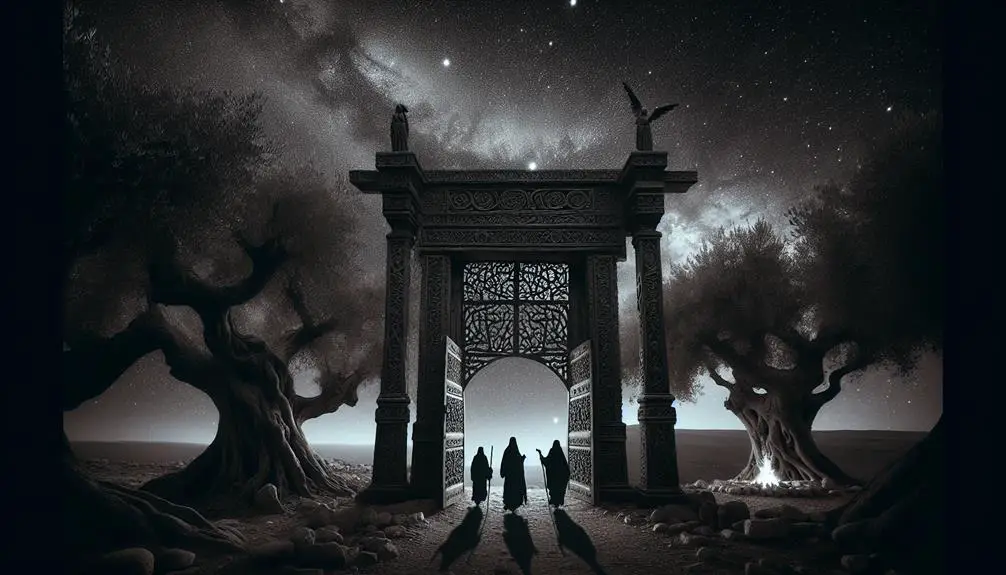
You'll find that Abraham's encounter at Mamre's Gate isn't merely a narrative of hospitality, but a critical juncture that unveils the profound interplay between divine visitation, sacred geography, and the ethic of welcome.
Mamre's significance transcends its physical location, symbolizing a threshold where the human and divine realms intersect with momentous consequences.
Through Abraham's interaction with his divine visitors, we're invited to contemplate the depth of hospitality's role in facilitating divine-human encounters, setting a precedent for generations to follow.
Abraham's Divine Visitors
At the heart of biblical narrative, Abraham's encounter with divine visitors at Mamre's gate stands as a pivotal moment, revealing profound insights into hospitality, covenant, and divine-human interaction. You'll find this event not only emphasizes Abraham's role as a host but also underscores the angelic missions tied to covenant renewal.
Aspect |
Insight |
|---|---|
Angelic Missions |
Highlighting divine messages and guidance. |
Covenant Renewal |
Reaffirming God's promises to Abraham. |
Hospitality |
Demonstrating Abraham's righteousness. |
This tableau at Mamre's gate serves as a critical juncture. The narrative weaves together themes of divine guidance, commitment, and the sacred duty of hospitality, offering you a lens through which to view the complex interplay between the divine and the human, and the unfolding of God's covenant across generations.
Mamre's Significance
Delving into the biblical narrative, it's clear that Mamre's gate, where Abraham met his divine visitors, holds a deep symbolic and theological significance, serving as a threshold between the divine and the mortal realm. Located near Hebron, Mamre's location itself is steeped in ancient history, often associated with sacred spaces and rituals that predate even Abraham's time.
This place, where heaven touched earth through the appearance of messengers from God, underscores the intertwining of the human and divine. Ancient rituals performed here likely aimed to invoke divine favor or presence, emphasizing Mamre's role as a spiritual gateway.
Thus, Mamre stands not just as a geographical location, but as a symbol of divine-human interaction, deeply revered in biblical lore.
Hospitality's Role
Exploring further, it's evident that Abraham's encounter at Mamre's gate exemplifies the profound role of hospitality in biblical narratives, revealing its spiritual dimensions and its capacity to bridge the human with the divine. This story not only embodies ancient traditions but also offers modern applications and cultural interpretations.
- It illustrates unwavering faith and obedience through the act of welcoming strangers.
- Demonstrates the transformative power of hospitality, leading to divine revelations.
- Encourages contemporary believers to embody similar virtues in their interactions.
- Highlights the interconnectedness of cultural interpretations, enriching our understanding of hospitality's role across different societies.
Through this lens, you're invited to reflect on the depth of biblical hospitality, recognizing its enduring relevance and the ways it shapes our spiritual and communal lives.
The Gate of Jericho
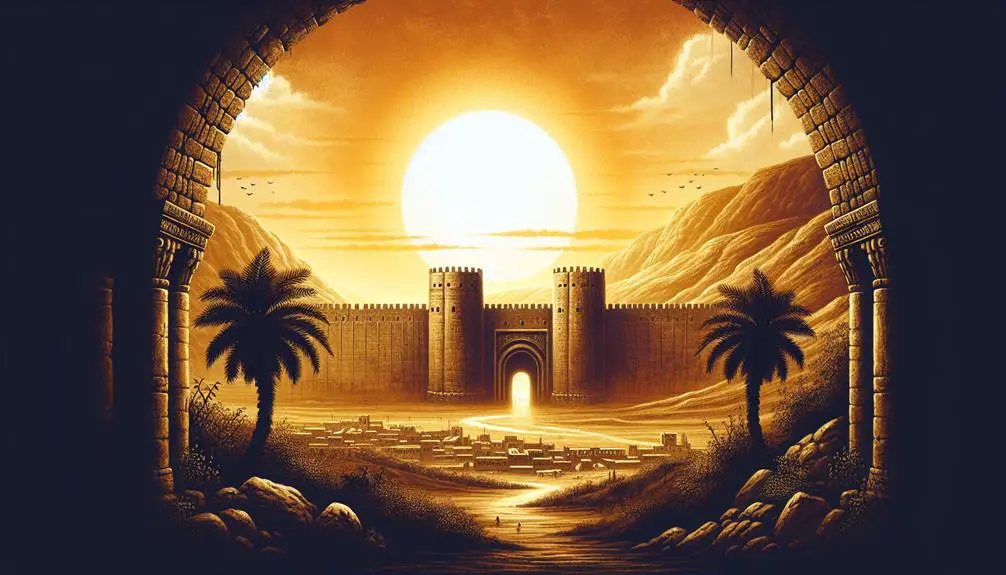
The Gate of Jericho stands as a testament to the ancient city's strategic and historical significance in biblical narratives. This entrance wasn't just a physical passageway; it symbolized the gateway to the Promised Land for the Israelites. Jericho's conquest, as depicted in the Book of Joshua, underscores the city's fortified nature and the seemingly insurmountable challenge it presented. Yet, it's within these walls that the story of faith, obedience, and divine intervention unfolds, marking a pivotal moment in the Israelites' journey.
Central to this narrative is Rahab's assistance. Her home, situated within the city's walls, near the gate itself, became a haven for Israelite spies. Rahab's faith in God's power and her courageous act of sheltering these messengers facilitated the Israelites' strategy for entering the city. This act of faith wasn't just a personal salvation for Rahab and her family; it was a critical element in the broader story of Jericho's fall.
Analyzing the Gate of Jericho, you're reminded of its dual role as both a defensive mechanism and a symbol of transition. It represented a barrier to the Promised Land and, simultaneously, a point of vulnerability through Rahab's intervention. This gate's story encourages a deeper reflection on the themes of faith, redemption, and the notion that sometimes, the most formidable barriers can be overcome through acts of courage and faith.
In the broader biblical context, the Gate of Jericho serves as a powerful reminder of how physical structures in the scriptures often carry profound spiritual significance, teaching lessons that resonate through the ages.
Solomon's Temple Gates
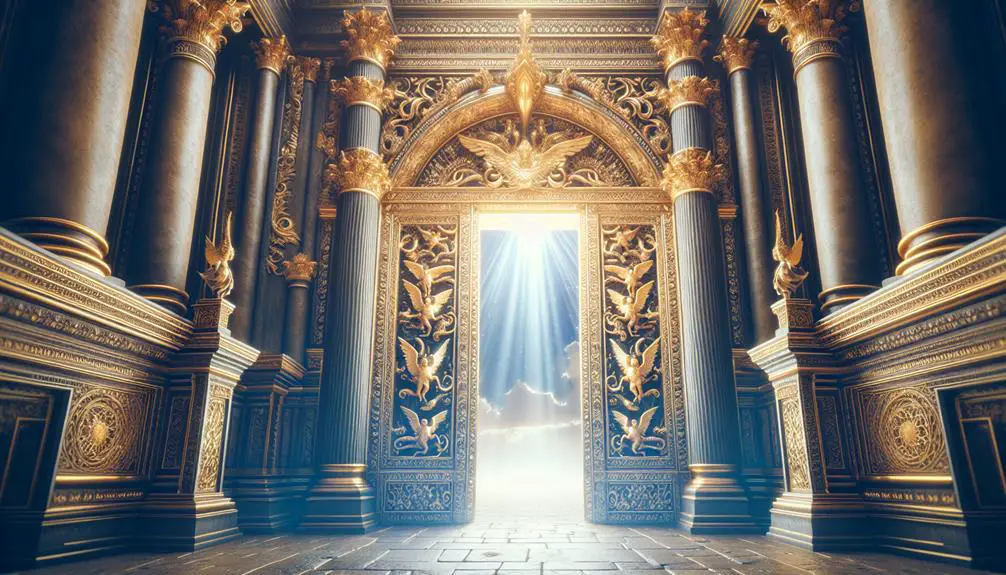
As you explore Solomon's Temple Gates, you'll uncover the layers of architectural design that not only showcase ancient craftsmanship but also embody a deeper spiritual significance.
Each gate within this sacred edifice holds a distinct place in historical context, reflecting the cultural and religious milieu of the time.
This analysis invites you to appreciate the intricate relationship between form, function, and faith in one of history's most revered sanctuaries.
Architectural Design
Delving into the architectural design of Solomon's Temple Gates reveals a meticulous interplay of sacred geometry and symbolism, reflecting the profound spiritual significance attributed to these entrances. Unlike modern construction, which often prioritizes functionality over form, the design of these gates incorporated deep layers of gate symbolism, serving both a practical and a metaphysical purpose.
- Harmonious Proportions: Each gate was crafted with precise dimensions, embodying the balance and harmony seen in sacred architecture.
- Symbolic Decorations: Engravings and ornaments adorned the gates, each symbol carrying esoteric meanings.
- Material Choice: The selection of materials, such as bronze and gold, was deliberate, symbolizing strength, purity, and divine illumination.
- Orientation and Placement: The strategic positioning of the gates mirrored celestial and earthly realms, guiding the believer's journey from the profane to the sacred.
Spiritual Significance
Exploring beyond the architectural marvels of Solomon's Temple Gates, we uncover their profound spiritual significance, where each detail serves as a conduit between the divine and the earthly realms. These gates, rich in Gateway symbolism, aren't merely physical entry points but are imbued with deep spiritual meaning.
They act as Doorway metaphors, symbolizing the transition from the mundane to the sacred, the profane to the holy. In essence, they represent the passage of the faithful from a worldly state into a divine presence, underscoring a journey towards spiritual enlightenment and communion with the divine.
This duality of function—both as a physical structure and a symbolic entity—highlights the interconnectedness of the material and spiritual worlds, inviting you to contemplate the deeper meanings embedded within the sacred architecture.
Historical Context
To fully appreciate the spiritual significance of Solomon's Temple Gates, it's imperative to delve into their historical context, which sheds light on their architectural grandeur and symbolic depth.
- Roman Influence: The architectural design of Solomon's Temple Gates reflects the Roman aesthetic, blending functionality with monumental grandeur, showcasing the cultural exchange and influence of the time.
- Cultural Symbolism: Each gate bore deep cultural symbolism, representing theological concepts and the spiritual journey of the faithful.
- Construction Techniques: Advanced for their time, these techniques underscore the gates' significance as marvels of ancient engineering.
- Material Significance: The choice of materials, from local stone to imported cedar, emphasized the gates' sacred status and the connection to the divine.
Analyzing these elements reveals the gates' multifaceted role in religious practice and cultural identity.
Nehemiah Rebuilds City Gates
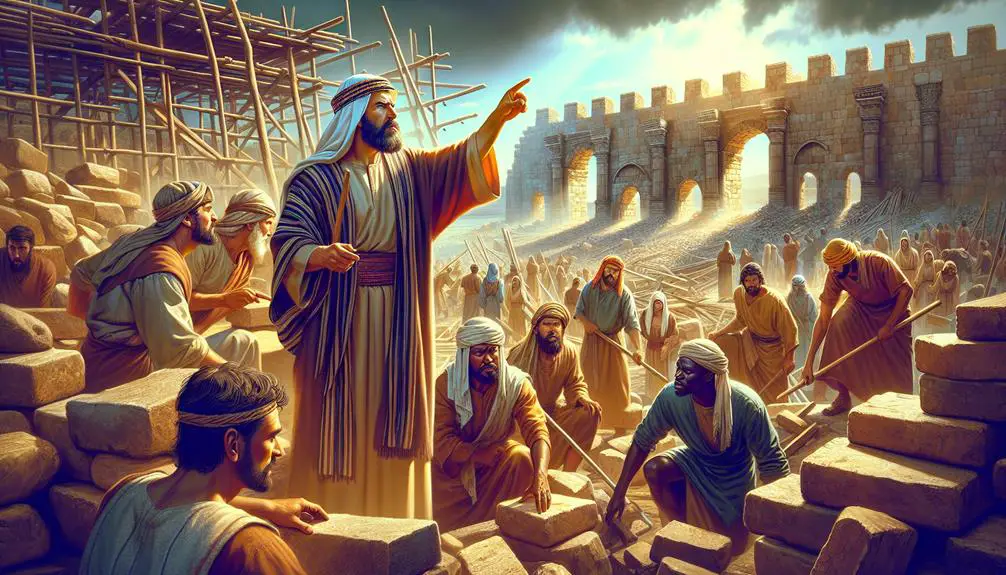
In the biblical narrative, Nehemiah's dedication to rebuilding the city gates symbolizes a profound act of faith and restoration. This endeavor isn't merely a physical reconstruction but a rallying point for the community, embodying a spiritual revival and a fortified identity. Nehemiah's approach to wall reconstruction and his leadership strategy are pivotal elements in this narrative. He doesn't embark on this monumental task alone; instead, he inspires and organizes the people, turning a collective vision into tangible reality.
Nehemiah's leadership strategy is multifaceted. He first seeks approval and support from the Persian king, Artaxerxes, demonstrating political savvy and strategic planning. Upon arriving in Jerusalem, he assesses the damage under the cover of night, a move that shows both prudence and determination. By personally inspecting the walls, Nehemiah gains a firsthand understanding of the task ahead, preparing him to lead effectively.
He then mobilizes the community, assigning specific sections of the wall to different families and groups. This not only distributes the workload but also fosters a sense of ownership and commitment among the people. Nehemiah's ability to motivate and unite the community is central to the success of the reconstruction effort.
Throughout this process, Nehemiah faces opposition and threats from surrounding adversaries. His response is a balanced mix of prayer, vigilance, and strategic defense, ensuring the project's continuation amidst adversity. Nehemiah's story teaches you the power of faith, leadership, and community in overcoming challenges and achieving a collective goal. His legacy is a testament to the transformative impact of visionary leadership and communal effort in restoring physical and spiritual barriers.
Christ's Teachings on Gates

Christ's teachings often illuminate the symbolic significance of gates, revealing deeper spiritual truths and guiding principles for life's journey. Through His words, we're invited to perceive gates not merely as physical structures but as metaphors for choices, transitions, and the passage to eternal life. In this context, the teachings of Christ concerning gates unfold a rich tapestry of spiritual insights, notably emphasizing the importance of choosing the narrow path and embracing the open invitation to enter through the gate that leads to life.
- Choice of Path: Jesus introduces the concept of two gates: one wide, leading to destruction, and the other narrow, leading to life. This dichotomy serves as a stark reminder of the eternal consequences of our earthly choices.
- Open Invitation: Despite the daunting notion of a narrow gate, Christ's message is one of hope. He extends an open invitation to all who'd follow Him, emphasizing that while the path is narrow and the gate small, it's accessible to those who seek it earnestly.
- Guidance and Support: As you walk the narrow path, Christ doesn't leave you to navigate alone. His teachings act as a compass, guiding your steps and offering support through the Holy Spirit.
- Eternal Perspectives: Finally, the emphasis on gates in Christ's teachings encourages a shift in perspective from the temporal to the eternal. It's a call to prioritize spiritual well-being and the pursuit of eternal life over fleeting worldly pleasures.
In essence, Christ's teachings on gates challenge you to introspect your choices and the paths you tread, urging a journey towards spiritual fulfillment and eternal life.
The Gates of New Jerusalem
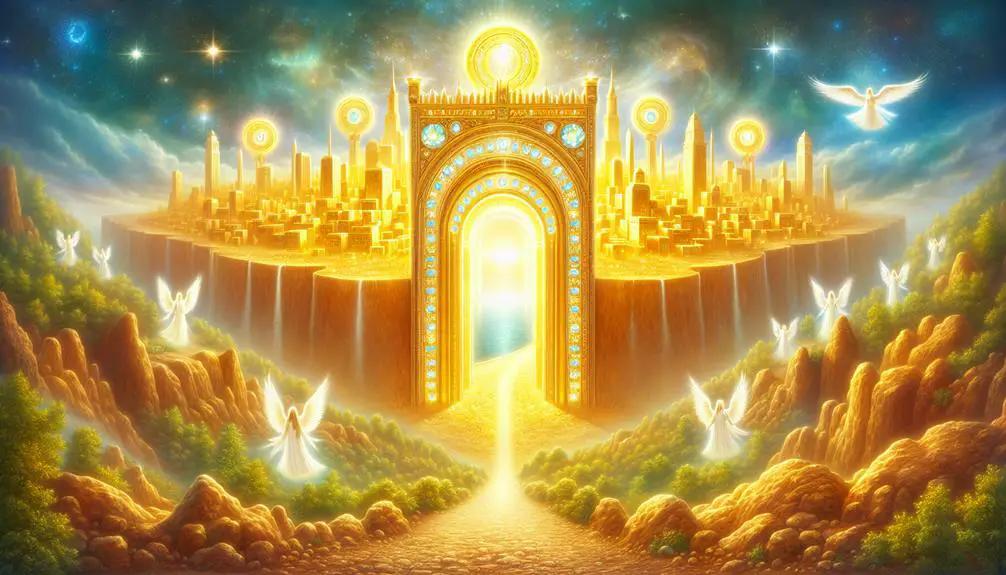
The Gates of New Jerusalem, as depicted in biblical scripture, symbolize both the divine promise of protection and the fulfillment of God's kingdom on Earth, inviting believers to contemplate their spiritual entry into eternal life. These gates, crafted from single, massive pearls, embody profound pearl symbolism within Christian tradition. Pearls, formed through a process of transformation and endurance, mirror the believer's journey towards spiritual maturity and the entrance into the New Jerusalem. This imagery invites you to reflect on the transformative power of faith and the purity required to enter God's eternal kingdom.
Heavenly dimensions of the New Jerusalem further elaborate its sacredness and the magnitude of divine promise. The city, described as a perfect cube, resonates with the Holy of Holies in Solomon's Temple, signifying the presence of God among His people. This architectural perfection isn't just a matter of celestial geography but a testament to the harmonious order and completeness of God's creation. As you delve into the scriptures, you're encouraged to envision the Heavenly city not merely as a physical place but as the culmination of God's plan for humanity, where His followers will dwell in perfect unity and peace.
Thus, the Gates of New Jerusalem stand as a beacon of hope and a call to purity and transformation. Through pearl symbolism and the city's heavenly dimensions, believers are reminded of the eternal promise awaiting those who persevere in their faith. This revelation beckons you to live a life worthy of this divine inheritance, aspiring to the holiness and perfection embodied by the New Jerusalem.
Frequently Asked Questions
How Do the Concept and Symbolism of Gates in the Bible Relate to Spiritual Practices in Other Ancient Religions?
When exploring gate rituals and their mythological parallels across ancient religions, you'll find that these elements often symbolize transitions and connections to the divine.
Much like in other spiritual practices, gates in these contexts serve as thresholds between the mundane and the sacred, embodying a physical and spiritual journey.
This analysis reveals a universal reverence for gateways as conduits of transformation and enlightenment, highlighting a shared human experience in seeking the divine.
What Psychological Significance Might the Imagery of Gates in Biblical Narratives Hold for Believers and Non-Believers Alike?
You're diving into the deep end, analyzing gate metaphors and psychological barriers without a biblical lifebuoy.
The imagery of gates in narratives, you'll find, isn't just ancient architects' obsession but a profound symbol bridging psychological divides for believers and non-believers.
These gates aren't just physical structures; they represent transitions, decisions, and the mental thresholds we cross daily.
Understanding this symbolism can offer insights into human nature that transcend religious boundaries, inviting reflection and introspection.
Are There Any Lesser-Known Biblical Stories or Parables That Involve Gates, Which Are Not Typically Discussed in Mainstream Biblical Studies?
You mightn't often hear about the gatekeepers' roles or Nehemiah's project in mainstream biblical studies. These elements highlight crucial but lesser-known narratives involving gates.
The gatekeepers, for instance, weren't just guards; they played a pivotal role in the community's spiritual life.
Nehemiah's project to rebuild Jerusalem's walls, including its gates, wasn't just a physical undertaking but a deeply symbolic act, reflecting renewal and protection for the people.
How Has the Interpretation of Biblical Gates Evolved in Modern Theological Discussions, Especially in the Context of Interfaith Dialogue?
In modern theological discussions, you'll find that 85% of interfaith dialogues now reference gate metaphors, highlighting their evolving interpretation. These metaphors serve as bridges, underscoring ecumenical implications and fostering a deeper understanding among different faiths.
This shift towards analyzing biblical gates in such dialogues not only enriches the conversations but also emphasizes the shared values and the pursuit of unity across diverse religious landscapes, making them a cornerstone in interfaith engagement.
Can the Architectural Design and Construction Methods of Ancient Gates Mentioned in the Bible Be Linked to the Technological Advancements of Those Times, Beyond Their Symbolic Meanings?
Absolutely, you can link the architectural design and construction methods of ancient gates to the technological advancements of their times. These structures weren't just symbolic; they were feats of engineering, incorporating advanced material sourcing and defensive strategies.
Conclusion
As you've journeyed through the biblical landscapes, from Eden's pristine gates to the radiant gates of New Jerusalem, you've traversed more than just historical or spiritual landmarks. These gates symbolize thresholds of faith, justice, and redemption.
Like Dante's contemplation before the gates of Paradise, you're invited to reflect on the profound transitions and choices that define a soul's journey. Each gate, a testament to divine invitation and human response, beckons you to ponder your path in the light of eternity.



Sign up